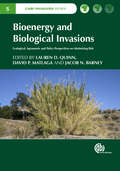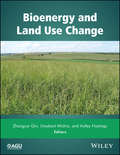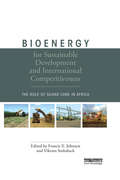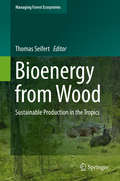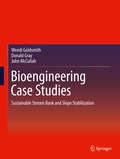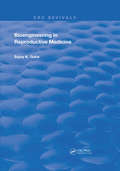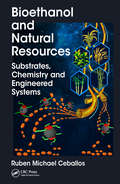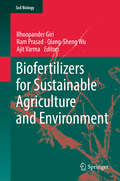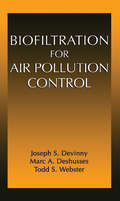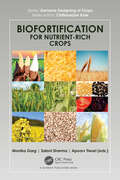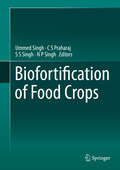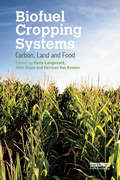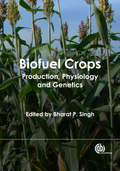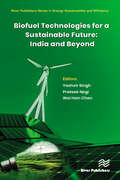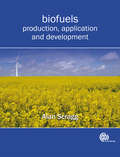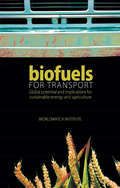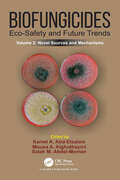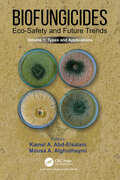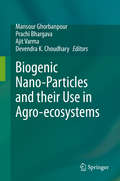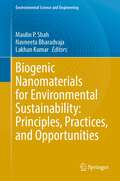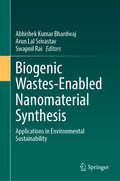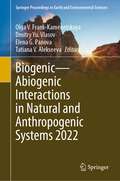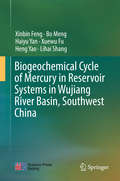- Table View
- List View
Bioenergy and Biological Invasions: Ecological, Agronomic and Policy Perspectives on Minimizing Risk (Plant Science / Horticulture Ser. #5)
by Rachel Bethke Carol Mallory-Smith Russell Jessup Stephen F Enloe Caroline E Ridley Phang Siew Moi Larissa Smith Bryan Endres Lloyd NackleyDespite major international investment in biofuels, the invasive risks associated with these crops are still unknown. A cohesive state-of-the-art review of the invasive potential of bioenergy crops, this book covers the identified risks of invasion, distributions of key crops and policy and management issues. Including a section on developing predictive models, this book also assesses the potential societal impact of bioenergy crops and how to mitigate invasive risks.
Bioenergy and Land Use Change
by Zhangcai Qin Umakant Mishra Astley HastingsAlthough bioenergy is a renewable energy source, it is not without impact on the environment. Both the cultivation of crops specifically for use as biofuels and the use of agricultural byproducts to generate energy changes the landscape, affects ecosystems, and impacts the climate. Bioenergy and Land Use Change focuses on regional and global assessments of land use change related to bioenergy and the environmental impacts. This interdisciplinary volume provides both high level reviews and in-depth analyses on specific topics. Volume highlights include: Land use change concepts, economics, and modeling Relationships between bioenergy and land use change Impacts on soil carbon, soil health, water quality, and the hydrologic cycle Impacts on natural capital and ecosystem services Effects of bioenergy on direct and indirect greenhouse gas emissions Biogeochemical and biogeophysical climate regulation Uncertainties and challenges associated with land use change quantification and environmental impact assessments Bioenergy and Land Use Change is a valuable resource for professionals, researchers, and graduate students from a wide variety of fields including energy, economics, ecology, geography, agricultural science, geoscience, and environmental science.
Bioenergy for Sustainable Development and International Competitiveness: The Role of Sugar Cane in Africa
by Francis X. JohnsonGrowing concerns about the impacts of climate change and dependence on fossil fuels have intensified interest in bioenergy from sugar cane and other crops, highlighting important links between energy, environment and development goals. Sub-Saharan Africa is characterized by severe poverty; the possibility to exploit a renewable energy resource offers valuable avenues for sustainable development and could support a more dynamic and competitive economy. This book describes how the bioenergy expansion will improve rural livelihoods, reduce costly energy imports, reduce GHG emissions, and offer new development paths. Drawing on international experience, it is shown that harnessing this potential will require significant increases in investment, technology transfer, and international cooperation. Because of its high efficiency, the authors argue that sugar cane should be viewed as a global resource for sustainable development and should command much greater focus and concerted policy action. Through an analysis of the agronomy, land suitability and industrial processing of sugar cane and its co-products, along with an assessment of the energy, economic and environmental implications, this volume demonstrates that sugar cane offers a competitive and environmentally beneficial resource for Africa's economic development and energy security. With forty-four authors representing thirty organisations in sixteen countries, the book offers a truly international and interdisciplinary perspective by combining technical and economic principles with social, political and environmental assessment and policy analysis.
Bioenergy from Wood: Sustainable Production in the Tropics (Managing Forest Ecosystems #26)
by Thomas SeifertThis book is written for scientists and practitioners interested in deepening their knowledge of the sustainable production of bioenergy from wood in tropical and sub-tropical countries. Utilising the value chain concept, this book outlines the necessary aspects for managing sustainable bioenergy production. A wide range of topics is covered including biomass localization, modelling and upscaling, production management in woodlands and plantations, and transport and logistics. Biomass quality and conversion pathways are examined in order to match the conversion technology with the available biomass. A section is dedicated to issues surrounding sustainability. The issues, covered in a life-cycle assessment of the bioenergy system, include socio-economic challenges, local effects on water, biodiversity, nutrient-sustainability and global impacts. Through this holistic approach and supporting examples from tropical and sub-tropical countries, the reader is guided in designing and implementing a value chain as the main management instrument for sustainable wood.
Bioengineering Case Studies: Sustainable Stream Bank and Slope Stabilization
by Wendi Goldsmith Donald Gray John Mccullah"Bio-Stabilization Case Studies: Treatment and Performance Evaluation" describes and evaluates 30 projects from across the United States where bio-stabilization was employed to address a detrimental naturally occurring process or byproduct of the built environment. Bio-stabilization (or soil bioengineering) refers to the use of plant materials, primarily live cuttings, arranged in the ground in different arrays to reinforce soils and protect upland slopes and/or stream banks against surficial erosion and shallow slope failures. Examples included in the collection represent different regions of the country and their specific conditions and challenges. Each project is illustrated with a number of distinctive photographs to support the reader's understanding and showcase the wide scope of projects and techniques presented. The volume is ideal for civil and environmental engineers and environmental scientists working on watershed, infrastructure projects, and municipal scale installations.
Bioengineering in Reproductive Medicine (Routledge Revivals)
by Sujoy K. GuhaFirst published in 1990: The book discusse the use of Biomedical engineering in Reproductive Medicine.
Bioethanol and Natural Resources: Substrates, Chemistry and Engineered Systems
by Ruben Michael CeballosBioethanol and Natural Resources: Substrates, Chemistry and Engineered Systems provides a comprehensive review of feedstocks, physiochemical and biological pretreatments, molecular substrates, cellulolytic and ligninolytic enzymes, and advanced technologies for producing bioethanol. Although this book provides a review of first-generation bioethanol feedstocks, chemistry, and processes, there is an emphasis on second-generation "cellulosic" ethanol production. With rapid advances in biofuels technologies and the continued global dependency on unsustainable extraction of fossil fuels, this text is timely. Although it is intended to be used as a supplemental text for advanced undergraduate or graduate level courses, the book is accessible to a non-academic audience. This book provides a unique opportunity to understand bioethanol production from the basic concepts and processes to the most cutting-edge technologies under development.
Biofertilizers for Sustainable Agriculture and Environment (Soil Biology #55)
by Ajit Varma Ram Prasad Qiang-Sheng Wu Bhoopander GiriThis book provides a comprehensive overview of the benefits of biofertilizers as an alternative to chemical fertilizers and pesticides.Agricultural production has increased massively over the last century due to increased use of chemical fertilizers and pesticides, but these gains have come at a price. The chemicals are not only expensive; they also reduce microbial activity in agricultural soils and accumulate in the food chain, with potentially harmful effects for humans. Accordingly, it is high time to explore alternatives and to find solutions to overcome our increasing dependence on these chemicals.Biofertilizers, which consist of plant remains, organic matter and microorganisms, might offer an alternative. They are natural, organic, biodegradable, eco-friendly and cost-effective. Further, the microbes present in the biofertilizers are important, because they produce nutrients required for plant growth (e.g., nitrogen, phosphorus, potassium), as well as substances essential for plant growth and development (e.g., auxins and cytokinins). Biofertilizers also improve the physical properties, fertility and productivity of soil, reducing the need for chemical fertilizers while maintaining high crop yield. This makes biofertilizers a powerful tool for sustainable agriculture and a sustainable environment.The book covers the latest research on biofertilizers, ranging from beneficial fungal, bacterial and algal inoculants; to microbes for bioremediation, wastewater treatment; and recycling of biodegradable municipal, agricultural and industrial waste; as well as biocontrol agents and bio-pesticides. As such, it offers a valuable resource for researchers, academics and students in the broad fields of microbiology and agriculture.
Biofiltration for Air Pollution Control
by Joseph S. Devinny Marc A. Deshusses Todd Stephen WebsterThe number-one environmental threat to public health, air pollution remains a pressing problem-made even more complicated by the massive quantity and diversity of air pollution sources.Biofiltration technology (using micro-organisms growing on porous media) is being recognized as one of the most advantageous means to convert pollutants to harmless products. Done properly, biofiltration works at a reasonable cost-utilizing inexpensive components, without requiring fuel or generating hazardous by-products.Firmly established in Europe, biofiltration techniques are being increasingly applied in North America: Biofiltration for Air Pollution Control offers the necessary knowledge to "do it right."
Biofortification for Nutrient-Rich Crops (Genome Designing of Crops)
by Monika Garg Saloni Sharma Apoorv TiwariBiofortification is a widely accepted cost-effective agricultural strategy to improve the nutrient deficiency in populations. It is especially useful in low income and developing nations. Strategies for biofortification employ crop breeding, targeted genetic alteration, and agronomy, show promise for addressing multiple forms of human malnutrition. To increase the bioavailability of food nutrients, biofortification efforts must focus on improving the nutrient content of food and decreasing anti-nutrients.This book covers the basics of biofortification, international efforts, challenges, opportunities, and the use of the latest omics technologies in addition to classical approaches. It covers the most studied micronutrients, vitamin biofortification, and the new topics in dietary fibers, starch quality, and phenolics. It uniquely covers the antinutrients like phytic acid, ODAP, and Glucosinolates. It also reviews food bioavailability, scientific research, and meta-analyses to assess the health-promoting efficacy of different nutrients. The book attempts to cover all bases, from decision considerations to prospects, as well as biofortification of nutrients, antinutrient reduction, and the use of latest technology to aid in the nutritional enhancement of virtually all recorded food crops.
Biofortification of Food Crops
by Ummed Singh C S Praharaj S S Singh N P SinghThe chapters presented in this book 'Biofortification of Food Crops' depict how agricultural technological interventions have true role in alleviating malnutrition. This book highlights the role of multidisciplinary approaches to cope up with the challenges of micronutrient malnutrition or hidden hunger which is an alarming public health issue in most parts of the world including India. In this endeavour, different biofortification approaches such as agronomic (or ferti-fortification), breeding, biotechnological, physiological, microbial etc. has fulfilled their different mandates of nutrient enrichment of food crops including cereals and pulses. The contents of the book proves that biofortified plants have adequate potential to nourish nutrient depleted soils, help increase crop productivity and provide nutritional benefits to plants, humans and livestock. The content and quality of information presented in this book will definitely provide multiple novel ideas of advance techniques and will stimulate innovative thoughts and directions amongst researchers and policy makers in the field of biofortification. In addition, the contributions presented in the book will be a good source of background knowledge and technical know-how to educate the readers about biofortification. The authors hope that the book entitled "Biofortification of Food Crops" would provide a suitable platform in our collective efforts for an appropriate dialogue among the scientists, researchers, entrepreneurs, policy makers and farmers in reducing the budding issues of malnutrition through novel approaches and means.
Biofuel Cropping Systems: Carbon, Land and Food
by John Dixon J.W.A. Langeveld Herman Van KeulenChoosing appropriate practices and policies for biofuel production requires an understanding of how soils, climate, farm types, infrastructure, markets and social organisation affect the establishment and performance of these crops. The book highlights land use dynamics, cultivation practices related to conversion and wider impacts. It explores how biofuel production chain development is steered by emerging technologies and management practices and how both can be influenced by effective policies designed to encourage sustainable biofuel production. The book highlights major biofuel production chains including: cane cultivation in Brazil corn ethanol in the USA wheat and rapeseed in Europe oil palm in the Far East cane in Asia and Africa SRC and other lignocellulosic crops. In each case the development, cropping systems and impacts are discussed, system dynamics are shown and lessons drawn for the way things could or should change. Biofuel Cropping Systems is a vital resource for all those who want to understand the way biofuels are produced and how they impact other elements of society and especially how improvements can be made. It is a handbook for students, biofuel producers, researchers and policymakers in energy and agriculture.
Biofuel Crops
by Bharat Singh Ratikanta Maiti Pratik Satya J G Isebrands Surinder S Banga Sujata Bhargava T K Biswas S Wani Steven E Mckeand Toshihiko Yamada Ralph Sims Ismail Dweikat Natalie S Betts Caitlin S Byrt L A Moraes S Hemaiswarya C Dana Nelson Belum V Reddy Jagannath Vishnu Patil Holger Schuhmann Somashekhar Punnuri Gary Stephan Banuelos N K Fageria John H Fike C M Williams Martin Weih Robert B Rummer Rachel A Burton Isabel S Carvalho P Srinivasa Rao Eric J Jokela Donald L Rockwood M Czako Ryan P Viator Peer M Schenk Bill Kovarik Leslie H Groom K C Falk A Moreira Kossonou Guillaume Anzoua Eric Obeng Christopher Q Lan Karaj Singh Dhillon R Raja C Ganesh Kumar A V Umakanth Masazumi Kayama David J Parrish Naser Farrokhi Anna Hale Gary F Peter R Ravikumar Serge Bracconnier Hari P Singh P J Minogue Kurt H Johnsen C Eynck L Marton K MuthukumarappanProviding comprehensive coverage on biofuel crop production and the technological, environmental and resource issues associated with a sustainable biofuel industry, this book is ideal for researchers and industry personnel. Beginning with an introduction to biofuels and the challenges they face, the book then includes detailed coverage on crops of current importance or with high future prospects, including sections on algae, sugar crops and grass, oil and forestry species. The chapters focus on the genetics, breeding, cultivation, harvesting and handling of each crop.
Biofuel Crops: Production, Physiology and Genetics
by Ratikanta Maiti Pratik Satya J G Isebrands Surinder S Banga Sujata Bhargava T K Biswas S Wani Toshihiko Yamada Ralph Sims Ismail Dweikat Natalie S Betts Caitlin S Byrt L A Moraes S Hemaiswarya C Dana Nelson Belum V Reddy Jagannath Vishnu Patil Holger Schuhmann Somashekhar Punnuri Gary Stephan Banuelos N K Fageria John H Fike C M Williams Martin Weih Robert B Rummer Rachel A Burton Isabel S Carvalho P Srinivasa Rao Eric J Jokela Donald L Rockwood M Czako Ryan P Viator Peer M Schenk Bill Kovarik Leslie H Groom K C Falk A Moreira Kossonou Guillaume Anzoua Eric Obeng Christopher Q Lan Karaj Singh Dhillon R Raja C Ganesh Kumar A V Umakanth Masazumi Kayama David J Parrish Naser Farrokhi Anna Hale Gary F Peter R Ravikumar Serge Bracconnier Hari P Singh P J Minogue Kurt H Johnsen C Eynck L Marton K Muthukumarappan Steven E McKeandProviding comprehensive coverage on biofuel crop production and the technological, environmental and resource issues associated with a sustainable biofuel industry, this book is ideal for researchers and industry personnel. Beginning with an introduction to biofuels and the challenges they face, the book then includes detailed coverage on crops of current importance or with high future prospects, including sections on algae, sugar crops and grass, oil and forestry species. The chapters focus on the genetics, breeding, cultivation, harvesting and handling of each crop.
Biofuel Technologies for a Sustainable Future: India and Beyond (River Publishers Series In Energy Sustainability And Efficiency Ser.)
by Yashvir Singh Prateek Negi Wei Hsin ChenThis book examines the key aspects that will define future sustainable energy systems: biofuels, green nanomaterials and the production of bioethanol and bio-hydrogen from bio-waste. Bio-based fuels are the future energy carriers for internal combustion engines as they have lower environmental impact and higher efficiency. The book clearly illustrates the requirement for a unified engineering approach based on solid mathematical and engineering principles. Aside from the ecological advantages, support for sustainable energy can help the socioeconomic situation of developing countries by providing a consistent supply of new energy along with the generation of new job opportunities. The sustainable energy applications and existing contextual investigations provide useful guidance for the broad comprehension of the significance of sustainable energy. Technical topics discussed in the book include: Thermochemical Conversion process; Catalytic conversion process; Rankine cycle; Nanomaterials;
Biofuels
by Alan ScraggProviding the world's growing population with its increasing demands for energy is a major challenge for science, business and society alike. Energy can be generated from many sources, but not all sources are suitable for every application. Much of today's technology has been built on solid, liquid and gaseous fuels derived from fossil sources. However, the supply of these is finite and their combustion produces carbon dioxide, one of the gases responsible for global warming. Therefore, alternative sources of energy are required which are renewable, sustainable and carbon neutral. This textbook explores the production of biofuels as alternatives to fossil fuels, focusing on the technological issues that need to be addressed for any new fuel source. Each type of biofuel currently in production is considered in detail, covering the benefits and problems with production and use and the potential for biological material to provide sufficient energy for the world's population - the principles on which future fuel development are based.
Biofuels for Transport: Global Potential and Implications for Sustainable Energy and Agriculture
by Worldwatch InstituteThe world is on the verge of an unprecedented increase in the production and use of biofuels for transport. The combination of rising oil prices, issues of security, climate instability and pollution, deepening poverty in rural and agricultural areas, and a host of improved technologies, is propelling governments to enact powerful incentives for the use of these fuels, which is in turn sparking investment. Biofuels for Transport is a unique and comprehensive assessment of the opportunities and risks of the large-scale production of biofuels. The book demystifies complex questions and concerns, such as thefood v. fuel debate. Global in scope, it is further informed by five country studies from Brazil, China, Germany, India and Tanzania. The authors conclude that biofuels will play a significant role in our energy future, but warn that the large-scale use of biofuels carries risks that require focused and immediate policy initiatives. Published in association with BMELV, FNR and GTZ.
Biofungicides: Novel Sources and Mechanisms, Volume 2
by Kamel A. Abd-Elsalam Mousa A. Alghuthaymi Salah M. Abdel-MomenThe current volume focuses on novel sources of biofungicides, primarily providing complete knowledge of microbial and phytochemical fungicides, studying antifungal activity mechanisms as well as their role in disease management in plants, and fungicide bioremediation. The use of biofungicides as eco-friendly alternative to typical synthetic fungicides is projected to play a significant role in organic farming in the future.Key Features: Discovers novel sources of biofungicides Describes the role of biofungicides in the control of plant diseases Studies antifungal activity mechanisms Explores how to survey and select promising biofungicides
Biofungicides: Types and Applications, Volume 1
by Kamel A. Abd-Elsalam Mousa A. AlghuthaymiThe current volume focuses on all the major concerns associated with the biofungicides and provides comprehensive knowledge of microbial and phytochemical fungicides, bioformulations, regulation as well as limitation of biofungicides, and their role in disease management in plants. The use of biofungicides as eco-friendly alternative to traditional synthetic fungicides is likely to play a major role in organic farming in the future.
Biogenic Nano-Particles and their Use in Agro-ecosystems
by Ajit Varma Devendra K. Choudhary Mansour Ghorbanpour Prachi BhargavaSeveral nano-scale devices have emerged that are capable of analysing plant diseases, nutrient deficiencies and any other ailments that may affect food security in agro-ecosystems. It has been envisioned that smart delivery systems can be developed and utilised for better management of agricultural ecosystems. These systems could exhibit beneficial, multi-functional characteristics, which could be used to assess and also control habitat-imposed stresses to crops.Nanoparticle-mediated smart delivery systems can control the delivery of nutrients or bioactive and/or pesticide molecules in plants. It has been suggested that nano-particles in plants might help determine their nutrient status and could also be used as cures in agro-ecosystems. Further, to enhance soil and crop productivity, nanotechnology has been used to create and deliver nano fertilizers, which can be defined as nano-particles that directly help supply nutrients for plant growth and soil productivity. Nano-particles can be absorbed onto clay networks, leading to improved soil health and more efficient nutrient use by crops. Additionally, fertilizer particles can be coated with nano-particles that facilitate slow and steady release of nutrients, reducing loss of nutrients and enhancing their efficiency in agri-crops. Although the use of nanotechnology in agro-ecosystems is still in its early stages and needs to be developed further, nano-particle-mediated delivery systems are promising solutions for the successful management of agri-ecosystems. In this context, the book offers insights into nanotechnology in agro-ecosystems with reference to biogenic nanoparticles. It highlights the: • occurrence and diversity of Biogenic Nanoparticles• mechanistic approach involved in the synthesis of biogenic nanoparticles• synthesis of nanoparticles using photo-activation, and their fate in the soil ecosystem• potential applications of nanoparticles in agricultural systems• application and biogenic synthesis of gold nanoparticles and their characterization• impact of biogenic nanoparticles on biotic stress to plants• mechanistic approaches involved in the antimicrobial effects and cytotoxicity of biogenic nanoparticles• role of biogenic nanoparticles in plant diseases management• relevance of biological synthesized nanoparticles in the longevity of agricultural crops • design and synthesis of nano-biosensors for monitoring pollutants in water, soil and plant systems• applications of nanotechnology in agriculture with special refer to soil, water and plant sciencesA useful resource for postgraduate and research students in the field of plant and agricultural sciences, it is also of interest to researchers working in nano and biotechnology.
Biogenic Nanomaterials for Environmental Sustainability: Principles, Practices, and Opportunities (Environmental Science and Engineering)
by Maulin P. Shah Navneeta Bharadvaja Lakhan KumarEnvironmental pollution is a worldwide concern now. A major section of the world population is struggling for drinking water. Polluted soil is resulting into low agricultural productivity and thus creating challenges in the way of sustainable livelihood of a large section of human population. Biological treatment can offer both green solutions for wastewater treatment and resource recovery as well. Like algal-based systems can be utilized for wastewater treatment and production of biofuels from the biomass grown on the wastewater. Bio-based nanomaterials have been extensively studied for their employability in the health care, process optimization, water resource management, dealing with environmental pollutants, biosensors, and many others. Bioprospecting of novel biological agents, bio-based products, and bioresource recovery are paving the way for sustainable development as they are providing local solutions for a number of problems.In this proposed book, we start with the introduction to bio-nanotechnological principles and later on discuss bio-based nanomaterials employability for a diverse range of applications from environment to energy to health care. This book provides with current trends in bio-nanotechnology for anthropogonic purposes, prospects, challenges, and way forward.
Biogenic Sedimentary Rocks in a Cold, Cenozoic Ocean: Neritic Southern Australia
by Noel P. James Yvonne BoneThis book documents and interprets the onshore Cenozoic temperate carbonate depositional system along the southern margin of Australia. These strata, deposited in four separate basins, together with the extensive modern marine system offshore, comprise the largest such cool-water carbonate system on the globe. The approach is classic and comparative but the information is a synthesis of recent research and new information. A brief section of introduction outlines the setting, modern comparative sedimentology offshore, and structure of the Cenozoic onshore. The core of the book is a detailed analysis and illustration of the four Eocene to Pleistocene successions. Deposits range from temperate carbonates, to biosiliceous spiculites, to marginal marine siliciclastics. Each unit is interpreted, as much as possible, based on our understanding of the modern offshore depositional system. A subsequent part concentrates on diagenesis both before and after the late Miocene uplift. It turns out that alteration in the two packages is entirely different. The preceding attributes of each succession are then interpreted on the basis of controlling factors such as tectonics, oceanography, climate, and glaciation of nearby Antarctica. This research has revealed new implications for the interpretation of specific attributes of cool-water carbonate sedimentology that could only be discovered from the rock record. Insights concerning cyclicity, reef mounds, biosiliceous deposition, and trophic resources are detailed in the next section. The concluding part focuses on global comparisons, especially the Mediterranean and New Zealand.
Biogenic Wastes-Enabled Nanomaterial Synthesis: Applications in Environmental Sustainability
by Arun Lal Srivastav Abhishek Kumar Bhardwaj Swapnil RaiThis book encompasses the knowledge about diverse types of advanced functional nanomaterial development using biogenic materials and associated applications along with various types of waste materials. Biomass generated from different industries has been long identified as major organic waste and it is a one of the major sources of contamination in the environment. This book will provide the global scenarios of low-cost biogenic materials and their suitability, pretreatment, and the ways to synthesize different kinds of nanomaterials (NMs) including carbonaceous, organic, inorganic and polymeric methods. The quantitative and qualitative characterization and applications of NMs will also be discussed in this book along with scientific and technical knowledge to manage suitable waste materials for NMs synthesis. Significant gaps and similarities between chemical synthesis and green synthesis along with their mechanism will be covered in detail as a point of comparison. The book will also contain the information on the need of policies required for waste management and option for their utilization along with the sources of their generation. The book also contains latest broad aspects of both practical and theoretical fabrication of metal NPs using biogenic waste materials. An emphasis has been made on the recent research related to advance NPs and their application. This book will be useful for undergraduate students, teachers, engineers and researchers, especially those working in areas of environmental science, material science, physical science, biotechnology, biochemistry and microbiology.
Biogenic—Abiogenic Interactions in Natural and Anthropogenic Systems 2022 (Springer Proceedings in Earth and Environmental Sciences)
by Olga V. Frank-Kamenetskaya Elena G. Panova Dmitry Yu. Vlasov Tatiana V. AlekseevaThe book represents a collection of papers presented at VII International Symposium "Biogenic-abiogenic interactions in natural and anthropogenic systems" that was held on 26-29 September 2022 in Saint Petersburg (Russia). Papers in this book cover a wide range of topics connecting with interactions between biogenic and abiogenic components in lithosphere, biosphere and technosphere. The main regarding topics are following: biomineralization in living organisms and nature-like materials; biomineralization in geosystems; geochemistry of biogenic-abiogenic systems; biomineral interactions in soil; interaction of microorganisms with natural and artificial materials; medical geology; philosophical aspects of interdisciplinary researchs
Biogeochemical Cycle of Mercury in Reservoir Systems in Wujiang River Basin, Southwest China
by Xinbin Feng Bo Meng Haiyu Yan Xuewu Fu Heng Yao Lihai ShangThis book presents an intensive study on the biogeochemical cycle of mercury in a river-reservoir system in Wujiang River Basin, the upper branch of the Yangtze River. Six reservoirs located in the mainstream of the Wujiang River and their corresponding inflow/outflow rivers were selected for inclusion in this study, which was conducted by researchers from the Institute of Geochemistry, Chinese Academy of Sciences. The concentration and distribution of Hg in reservoirs (the water column, sediment, sediment pore water), inflow/outflow rivers of reservoirs, and wet deposition in Wujiang River Basin were systematically investigated, and measurements were taken of the water/air exchange flux of gaseous elemental mercury (GEM). On the basis of the data gathered, a detailed mass balance of total mercury (THg) and methylmercury (MeHg) in the six reservoirs was developed. In addition, the book identifies the primary factors controlling Hg methylation in the river-reservoir system in Wujiang River Basin. The accumulation and bio-magnification of Hg species within food chains in reservoirs and human health risk of MeHg exposure through fish consumption are also included in this book.
